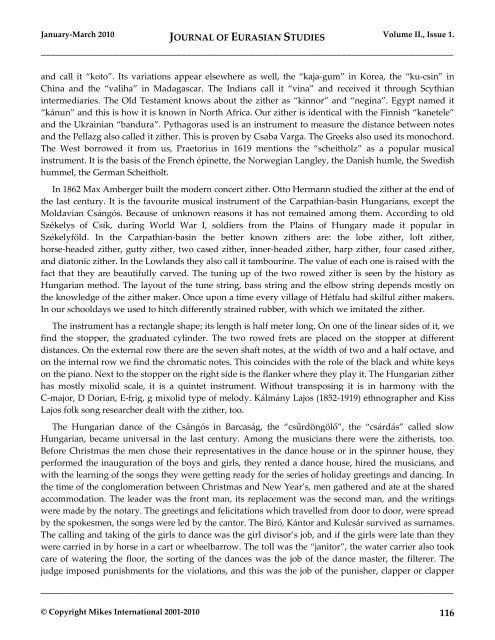EurasianStudies_0110..
EurasianStudies_0110..
EurasianStudies_0110..
You also want an ePaper? Increase the reach of your titles
YUMPU automatically turns print PDFs into web optimized ePapers that Google loves.
January-March 2010 JOURNAL OF EURASIAN STUDIES Volume II., Issue 1.<br />
_____________________________________________________________________________________<br />
and call it “koto”. Its variations appear elsewhere as well, the “kaja-gum” in Korea, the “ku-csin” in<br />
China and the “valiha” in Madagascar. The Indians call it “vina” and received it through Scythian<br />
intermediaries. The Old Testament knows about the zither as “kinnor” and “negina”. Egypt named it<br />
“kánun” and this is how it is known in North Africa. Our zither is identical with the Finnish “kanetele”<br />
and the Ukrainian “bandura”. Pythagoras used is an instrument to measure the distance between notes<br />
and the Pellazg also called it zither. This is proven by Csaba Varga. The Greeks also used its monochord.<br />
The West borrowed it from us, Praetorius in 1619 mentions the “scheitholz” as a popular musical<br />
instrument. It is the basis of the French épinette, the Norwegian Langley, the Danish humle, the Swedish<br />
hummel, the German Scheitholt.<br />
In 1862 Max Amberger built the modern concert zither. Otto Hermann studied the zither at the end of<br />
the last century. It is the favourite musical instrument of the Carpathian-basin Hungarians, except the<br />
Moldavian Csángós. Because of unknown reasons it has not remained among them. According to old<br />
Székelys of Csík, during World War I, soldiers from the Plains of Hungary made it popular in<br />
Székelyföld. In the Carpathian-basin the better known zithers are: the lobe zither, loft zither,<br />
horse-headed zither, gutty zither, two cased zither, inner-headed zither, harp zither, four cased zither,<br />
and diatonic zither. In the Lowlands they also call it tambourine. The value of each one is raised with the<br />
fact that they are beautifully carved. The tuning up of the two rowed zither is seen by the history as<br />
Hungarian method. The layout of the tune string, bass string and the elbow string depends mostly on<br />
the knowledge of the zither maker. Once upon a time every village of Hétfalu had skilful zither makers.<br />
In our schooldays we used to hitch differently strained rubber, with which we imitated the zither.<br />
The instrument has a rectangle shape; its length is half meter long. On one of the linear sides of it, we<br />
find the stopper, the graduated cylinder. The two rowed frets are placed on the stopper at different<br />
distances. On the external row there are the seven shaft notes, at the width of two and a half octave, and<br />
on the internal row we find the chromatic notes. This coincides with the role of the black and white keys<br />
on the piano. Next to the stopper on the right side is the flanker where they play it. The Hungarian zither<br />
has mostly mixolid scale, it is a quintet instrument. Without transposing it is in harmony with the<br />
C-major, D Dorian, E-frig, g mixolid type of melody. Kálmány Lajos (1852-1919) ethnographer and Kiss<br />
Lajos folk song researcher dealt with the zither, too.<br />
The Hungarian dance of the Csángós in Barcaság, the “csűrdöngölő”, the “csárdás” called slow<br />
Hungarian, became universal in the last century. Among the musicians there were the zitherists, too.<br />
Before Christmas the men chose their representatives in the dance house or in the spinner house, they<br />
performed the inauguration of the boys and girls, they rented a dance house, hired the musicians, and<br />
with the learning of the songs they were getting ready for the series of holiday greetings and dancing. In<br />
the time of the conglomeration between Christmas and New Year’s, men gathered and ate at the shared<br />
accommodation. The leader was the front man, its replacement was the second man, and the writings<br />
were made by the notary. The greetings and felicitations which travelled from door to door, were spread<br />
by the spokesmen, the songs were led by the cantor. The Bíró, Kántor and Kulcsár survived as surnames.<br />
The calling and taking of the girls to dance was the girl divisor’s job, and if the girls were late than they<br />
were carried in by horse in a cart or wheelbarrow. The toll was the “janitor”, the water carrier also took<br />
care of watering the floor, the sorting of the dances was the job of the dance master, the filterer. The<br />
judge imposed punishments for the violations, and this was the job of the punisher, clapper or clapper<br />
_____________________________________________________________________________________<br />
© Copyright Mikes International 2001-2010 116

















